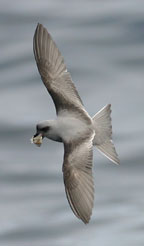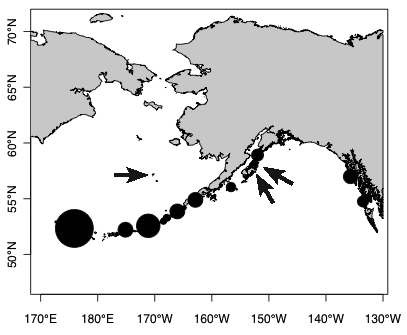Swallows of the Sea: the Fork-tailed Storm-Petrel—Fall 2007
Even while Rhinoceros Auklets made front page news wrecking on Northwest beaches last March, some of you noted an uptick in one of the tiniest seabirds in Beached Birds, the Fork-tailed Storm-Petrel. Alaskans, too, have already seen a few of them: all during late summer and early fall when the millions of Fork-tails breeding in Alaska disperse from colonies in the Aleutian Islands and Gulf of Alaska south to California Current System waters. Alaska is home to most of the population; Washington, Oregon and California support less than 10,000 breeding adults in several colonies scattered along the Pacific Coast.
Superficially similar to the other storm-petrel species likely to be found by COASSTers (the Leach’s), Fork-tails have lighter and grayer upper and underparts, dark wing linings, and dark facial coloration making them look as though they have black eyes. The name “petrel” actually originates from St. Peter, and describes the characteristic feeding behavior of these birds as they “walk across water.”

Fish please, hold the chips: a Fork-tailed Storm-Petrel makes off with a snack. (T. Guy )
During the breeding season, these swift little birds swoop in at night to burrows dug into vegetated hillsides or formed naturally by scree slopes. Chattering to mates and neighbors and trilling to eggs, a Fork-tailed colony is a noisy, social place. Parents take turns feeding their single chick a rich concoction of fish and invertebrates in a specially manufactured stomach oil. Imparted to feathers during preening, this oil gives Fork-tails, in fact all tubenoses, their characteristic sweet musky motor-oil smell.
With long, narrow wings enabling highly efficient flight, storm-petrels have a wide oceanic ambit. Even breeders may travel over 100 km one-way in search of food. Tube-shaped nostrils contribute to their keen sense of smell allowing Fork-tailed Storm-Petrels to home in on small fish, fish eggs, squid and other marine delectables.

Where do you find Fork-tailed Storm-Petrels in Alaska? Black circles indicate colony size and location. Arrows indicate COASST Fork-tailed Storm-Petrel finds. (M. Renner)
Feeding at the surface renders these small oceanic denizens particularly susceptible to oil spills and plastic pollution. A study in the Barren Islands, Alaska showed that the incidence of petroleum pollutants in stomach contents of Fork-tails increased significantly after an oil spill, because surface slicks often enveloped their prey. Commonly mistaken for fish eggs or small colorful crustaceans, plastic pellets and styrofoam beads may be inadvertently consumed as well. Despite their size, these tiny oceanic birds can tell us a great deal about what happens over a broad geographic area.
Just can’t get enough? Check out these sites for more information about Fork-tailed Storm-Petrels: